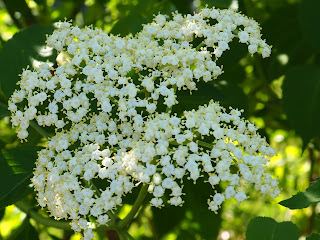On May 22, I had the opportunity to join landscape designer Deb De Vries and Land Trust Executive Director David Brant in establishing the new Native Plant Demonstration Garden at the preserve. While the back two-thirds of the preserve will remain a native meadow, the front third of the preserve showcases how native plants can be integrated into a cultivated landscape. This demonstration garden is central to one of the objectives of the Aspetuck Land Trust's Green Corridor Initiative, planting native plants to support pollinators and overall biodiversity.
65% of the property was planted this spring and the remaining plants will be installed this fall, pending native plant availability. For the past month, I have been focussing on watering and weeding the preserve, as well as observing the unfolding beauty of the native flowers.
 |
| The new Native Plant Demonstration Garden was featured on the Southport Garden Stroll on June 4, 2021. |
 |
The Sasqua Preserve is a model native landscape, showing homeowners how native plants can both beautify and increase biodiversity.
 | When planting native plants such as Pennsylvania sedge (Carex pensylvanica), I learned to dig a sufficiently deep hole so the root ball does not lie above the soil.
|
|
Each visit to the preserve offers a unique window into this "Native Garden in Process." Designer Deb De Vries created a phenological calendar to demonstrate the changing bloom cycle throughout the seasons, as flowers accent the preserve with red, yellow, blue, purple, pink, and gold. Golden Alexanders, blue eyed grass, husker red beardtongue, round leaf ragwort, blue flag iris, Southern sundrops, cranberry, tickseed, blazing star, butterfly weed, false sunflower, blueberry, and winterberry have all flowered so far this season. The bloom calendar is a reminder for me that native plants can not only increase biodiversity, but also beautify the landscape.
Like the Demonstration Garden, becoming ecologically sustainable involves embracing change and can be a work in process. Consider replicating the concept of the Native Plant Demonstration Garden in your own backyards by starting small. A 0.31 acre property or section of your yard may seem small by itself, but when connected on the Green Corridor to other preserves, open spaces, and homeowner landscapes, the impact is magnified. Each step in the process of land stewardship, such as switching to organic lawn care, planting native plants, and avoiding pesticides can become a stepping stone for further sustainable action. And, within the framework of the Green Corridor vision, one yard can blossom into a stepping stone for the birds and butterflies that travel throughout your landscape.
 |
A native bee visits the false sunflower (Heliopsis helianthoides)
|
 |
| Golden Alexanders (Zizia aurea) |
 |
| Blue eyed grass (Sisyrinchium angustifolium) |
 |
| Husker red beardtongue (Penstemon digitalis "Husker Red") |
 |
Roundleaf ragwort (Packera obovata)
|
|
|
|
 |
Blue flag Iris (Iris versicolor)
|
 |
| Southern sundrops (Oenothera fructicosa) |
 |
| Cranberry (Vaccinum macrocarpon) |
 |
| Tickseed (Coreopsis verticillata) |
 |
| Mercury Rising Tickseed (Coreopsis x Mercury Rising) |
 |
| Blazing star (Liatris spicata) |
 |
| Butterfly weed (Asclepias tuberosa) |
 |
| False sunflower (Heliopsis helianthoides) |
 |
| Highbush blueberry (Vaccinum corymbosum) |
 |
| Winterberry (Ilex verticillata) |
 |
| Highbush blueberry (Vaccinum corymbosum) blossoms |
 |
| Cabbage white (Pieris rapae) on the blazing star (Liatris spicata) |






















Comments
Post a Comment